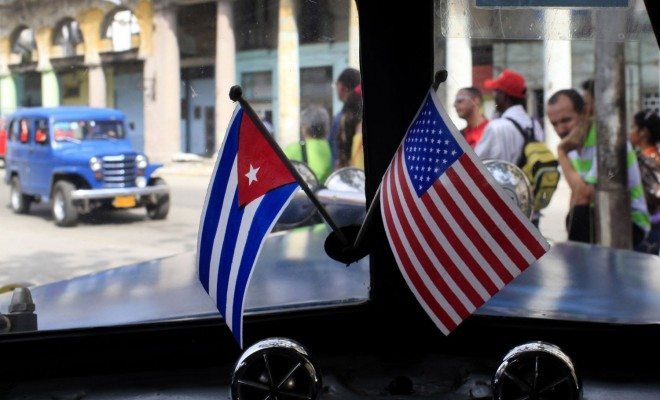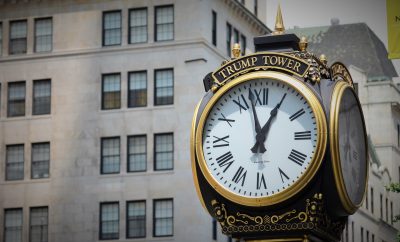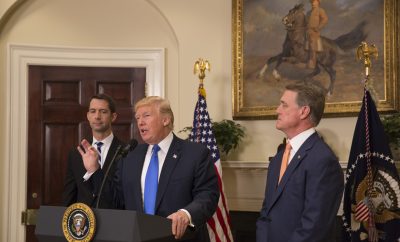 Image courtesy of [Day Donaldson via Flickr]
Image courtesy of [Day Donaldson via Flickr]
World
The U.S. and Cuba: The Path to Normalized Relations
On December 17, 2014 following a prisoner exchange, President Obama outlined efforts being made to normalize relations with Cuba. The announcement was monumental as it signaled a major change in a policy dating back to the Cold War. It was also vague. What exactly did this mean and how will the Cuban American community take this? To answer these questions it is necessary to go back in time and look at the relationship between the United States and Cuba from the beginning, from before the embargo to present day.
History
It’s easy to imagine that the relationship between Cuba and the United States only began when Fidel Castro became the ruling dictator; however, the two nations shared a bond that is much older than that era. It can be argued that it goes all the way back to the 1860s when, after seceding from the Union, the Confederacy believed it would eventually conquer the small island of Cuba and incorporate it as one of its states. A more concrete beginning to the relationship, however, lies in the events following the American victory in the Spanish-American War.
After the end of that war, Spain ended its claim to Cuba. The United States granted Cuba its independence, but this came with two conditions: first, that the United States had the right to intervene in Cuban affairs; and second, that the U.S. would be granted a continuous lease for a naval base, which would become the infamous Guantanamo Bay detention facility.
While the United States has clearly exercised the second right, it also made use of the first. The U.S. intervened in Cuban affairs by frequently helping to crush rebellions in the first half of the twentieth century, despite brutal crackdowns on dissent, which was one of the reasons it allegedly wanted to fight Spain for Cuba’s independence in the first place. Aside from American government overtures, American businesses also invested heavily in Havana, turning it into a popular vacation getaway. Even the Mafia became involved in Cuba, using it as a conference center and investing there heavily themselves.
The Cuban revolution occurred in 1959, and Fidel Castro overthrew the U.S.-supported Batista regime. The immediate aftermath did not foreshadow what was to come. In fact, in one of history’s odd turns of events, the United States quickly recognized Castro’s regime, and Castro himself came to visit Washington, D.C. just weeks after the successful coup.
The honeymoon phase, of course, did not last long. Along with Castro’s increasingly clear Communist leaning, he made efforts to nationalize private companies, including American ones, and impose heavy taxes on American goods, which served to sour the relationship. In response to heavy taxes on American goods, President Eisenhower in turn enacted trade restrictions allowing for only food and medical supplies to be shipped to the island. Outraged at what they deemed to be American imperialism, Cuban officials then increased trade with the Soviet Union. This proved to be the nail in the coffin; the United States severed all diplomatic ties and the permanent and infamous embargo was put into place in early 1962.
Sanctions & Embargo
The embargo itself both leveled economic sanctions on Cuba and restricted travel and commerce with the country for all people and companies under United States authority. The embargo was strengthened in 1963 with the Cuban Assets Control Regulations, which prohibited financial transactions with Cuba and outlawed the importation of Cuban-made goods. The embargo was further strengthened by two additional acts passed in the 1990s. According to these acts, the embargo could only be lifted if Cuba would:
Legalize all political activity, release all political prisoners, commit to free and fair elections in the transition to representative democracy, grant freedom to the press, respect internationally recognized human rights, and allow labor unions.
Since Cuba has not met these conditions yet the embargo has endured.
Diplomacy Under the Embargo
Since the enactment of the embargo, the two countries have been at strife, communicating only through Switzerland when necessary. Nevertheless, while the two nations were not talking they were still crossing each other’s paths. The action was greatest immediately following the embargo with the Bay of Pigs disaster and the Cuban Missile crisis, which nearly led to nuclear war between the U.S. and the Soviet Union.
In the Bay of Pigs operation, 1,400 Cuban exiles who had been trained in Guatemala were to land at night and begin guerilla operations against the Castro regime with the additional aid of U.S. airstrikes. The invasion faltered immediately when the airstrikes missed their target and the invading force met much stiffer resistance than expected. In the end, downed U.S. pilots were taken hostage and nearly the entire invading group was forced to either fall back, surrender, or was killed.
That operation led directly to the Cuban Missile Crisis. In that situation, Cuba asked for and was to receive Soviet nuclear weapons as a deterrent against future American attacks. The United States learned of the planned installation of nuclear weapons and a standoff briefly ensued when Cuba was quarantined by American naval ships. Eventually the Soviets agreed publicly to remove the weapons if the United States promised not to invade Cuba; privately the U.S. also removed nuclear weapons it had in Turkey.
Since the 1960s, the relationship can best be characterized as a standoff with each side occasionally making an effort to proverbially poke its rival. On Cuba’s part this includes releasing thousands of criminals and mentally ill and sending them to the beaches of Florida as exiles. For the United States, this has meant continuing to turn the screws and ratcheting up the intensity of sanctions, even while Cuba suffers from hunger and a grossly underdeveloped infrastructure.
The video below outlines Cuba and U.S. relations since Castro’s takeover.
The Winds of Change
Despite nearly 60 years of animosity, the relationship between the two nations began to change again following the election of President Barack Obama in 2008. As part of his original campaign platform, Obama had vowed to reduce restrictions on Cuban-Americans who want to visit relatives. Obama’s actions were two-fold: first, they allowed Cuban-Americans with family in Cuba to travel there freely, and they eliminated the cap on the amount of remittances people could send back. Secondly, people without family members in Cuba were also allowed to send capped remittances to the island, and could travel there with a license for educational or religious reasons. This also opened Cuba to companies that wished to provide cellular, television, and telephone services to the island.
Recent Developments
The last domino fell the day before the president made his speech on the path to normalization between Cuba and the United States when Alan Gross, an imprisoned USAID worker, was finally released and brought home to America in a prisoner exchange. The exchange was in part made possible through a dialogue brokered by Pope Francis who had invited the two sides to resolve their differences. Also, part of the agreement were pledges by both countries to open embassies in each other’s capitals. Additionally, the United States promised to further relax business and commercial travel restrictions with the island nation. Lastly, the U.S. has guaranteed to go even further by unfreezing bank accounts and agreeing to review Cuba’s designation as a state sponsor of terror.
The video below explains what exactly the president plans to do.
Obstacles
There are still several potential obstacles to the establishment of full relations. First is the large Cuban-American voting bloc in Florida, a traditionally pivotal swing state. Many Cuban-Americans want to see the entire Castro family regime removed before relations are normalized; however, that may be changing–while a 1991 FIU poll reported that 87 percent of Cuban-Americans supported the embargo, by the time Obama was elected in 2008 the majority had moved the other way. Although this reversed course yet again, by 2014 the majority of Cuban-Americans polled were once more in favor of lifting the embargo. Support was especially strong among young people, with 90 percent in favor of reestablishing diplomatic ties with Cuba. So, it’s difficult to tell conclusively what percentage of the Cuban-American population will be in favor of these more normalized relations.
Another obstacle is Cuba’s extremely poor human rights record. As mentioned earlier, one of the conditions for removing the embargo by the United States was that Cuba respect internationally recognized human rights. Cuba’s human rights record has remained dismal. In 2014, Human Rights Watch listed Cuba as “not free.” More specifically, in three indicators–freedom rating, civil liberties, and political rights–Cuba received scores of six and a half, six, and seven, respectively. The scale goes from one to seven, with seven being the worst. Clearly, if Cuba wants to lift the embargo and normalize relations with the U.S., improving its regard for human rights is something that needs a lot of work.
Most challenging for President Obama, however, is Congress. While the president can make some tweaks to the relationship himself, he needs Congress in order to abolish the embargo as it is codified into law. This will most likely prove especially difficult for a president who was not having much success dealing with Congress before Republicans won a majority in both the House and Senate in 2014; however, the political loyalties of Cuban-Americans themselves may alter the status quo.
Traditionally, Cuban-Americans have favored the Republican party; in 2002 according to a Pew poll, 64 percent favored Republicans. However, by 2014 only 47 percent favored Republicans and 44 percent now favored Democrats. This is partly a result of this demographic skewing younger, and the younger generation being overall more open to reconciliation. Whatever the reason may be, both parties now will likely work to secure this group’s loyalty. Thus, while the Republican Congress may be recalcitrant on many issues supported by the president, if it believes Cuban-Americans desire an end to the embargo and normalized Cuban relations with the United States, the prospect of that happening is much more likely. Congress may be especially eager to act if it means maintaining historical support from a key swing state supporter.
Potential Outcomes
While the Cato Institute estimates that the U.S. could gain as much as $1.2 billion annually from lifting the embargo on Cuba, the economic worth pales in comparison to other considerations. By finally lifting the embargo the United States could signal a major policy change from the Cold War tactics of years past and even the “democracy by force” doctrine that many people associate with the war in Iraq.
Furthermore, it could also signal to some of the United States’ other antagonists, namely Iran and North Korea, that there is another way dialogue can be established. It may even serve as a way to save face as the sanctions on both of those countries are also seemingly ineffective. Additionally, it may further add some lost luster to the United States’ image of being an international good guy and not a traditional Western imperialist. Specifically, for other developed critics of the United States such as Russia and China, this might remove some of their argument that the United States is hypocritical and has different policies for different countries based on its interests.
On a more personal level for President Obama, this could signal a foreign policy coup that seems needed after the debacle with the Syrian Red Line and ISIS. If the president is successful in this endeavor it might also secure an important voting bloc in a swing state for Democrats down the road. Of course it may also come back to bite the United States if Cuba doesn’t make any changes. It might make people worry yet again that the United States is weak and has no stomach for drawn out conflicts anymore, which could actually further embolden adversaries such as Iran and North Korea even more. Still, the potential to garner goodwill, end fruitless policies, and reassert the image of the United States as a haven for freedom seem to outweigh the bad and are also the most likely outcomes.
Conclusion
While many critics of normalizing relations with Cuba say that the president is essentially rewarding the country and prolonging the regime, their facts do not add up. Although Cuba certainly should be required to improve its human rights laws as part of any normalization, sanctions seemed to be ineffective. In today’s globalized world, countries cannot be shunned simply because their policies are not what we want them to be. This is especially relevant for nations such as Iran and North Korea that also draw Washington’s ire and are sanctioned accordingly for it. Rapprochement with Cuba therefore appears to have raised more questions than answers, but perhaps these questions are the key to an overall more successful foreign policy.
Resources
Primary
Council on Foreign Relations: US-Cuba Relations
Additional
NPR: Polls Show Cuban American Views
Cato Institute: Time to End Cuban Embargo
JFK Library and Museum: Bay of Pigs
Harvard Political Review: Reexamining the Cuban Embargo
Washington Post: US-Cuba Relations
NPR: Obama Eases Limits on Cuba Travel, Remittances
US Department of State: Cuban Missile Crisis
Pew Research Center: After Decades of GOP Support








Comments